Tips
Things that have not changed an iota in the last 3 decades:
* If you go by the standard Thanksgiving story, all the way back to 1622 (which in fairness to history you probably shouldn’t), tradition favors venison. But tradition as usually understood demands turkey. No other meat – or poultry – will do.
* It is impossible to roast a whole turkey and have both light and dark meat come out equally delicious.
* It is impossible to convince people that this means turkeys should not be roasted whole.
Things that have changed considerably:
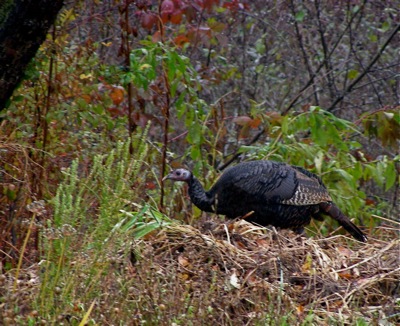
* Wild turkeys are back, big time, although not yet back on the table
* Cooks have discovered that brining the turkey does a great deal to help keep the meat moist. (Best dissenting opinion award: Harold Magee in the New York Times).
* The USDA has discovered it’s not necessary to create bird-flavored sawdust, i.e. internal temperature of thigh 180 degrees. The agency now allows you to stop at 165, still around 10 degrees hotter than essential for safety, but only about 5 degrees hotter than best for succulence.
* It’s no longer enough that the turkey be fresh, unpolluted by “self-basting” additives and unpierced by pop up buttons. Fresh and local is now the gold standard, except when you can get fresh, local and heritage, the high end turkey trifecta.
tips for dealing w/heritage turkeys, whichtend to be leaner and smaller than the modern standard, can be found at the end of this post.
tips for dealing with the modern standard, and the stuffing recipe follow
Read More…
It may be bundle up time ( we’ve had temps in the mid-20’s on several nights at this point) but there are still delicious wild mushrooms to be found. Here’s the latest from our resident expert.
THE MUSHROOMS OF AUTUMN
After The Leaf fall
story and photos by Bill Bakaitis
As the days shorten the trees shed their leaves, openings begin to appear in the canopy, and more light penetrates to the understory. Mild frosts will have singed the outer tips of the garden plants and the edges of the forest, but mushrooms such as Honeys can still be found poking through the thin cover of leaves under the thickest forest canopies.
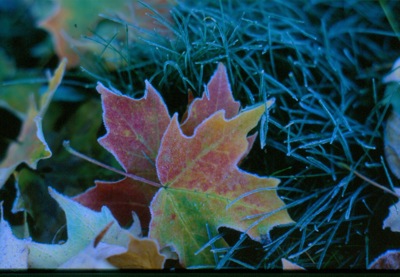
Light frost on Maple Leaves
By mid-Autumn, a month after equinox, It’s a different story. Read More…
10/23
Kristi and I are discussing the last bits of putting the garden to bed. We’re wondering about the winter rye, our standard cover crop for the Maine vegetable plots. She planted it 10 days ago but nothing seems to be coming up. Big Mystery. Seed was fresh, there has been rain…
10/24
Mystery solved first thing in the morning. I look out the bedroom window into the rosy dawn and there in the garden is a flock of wild turkeys, busily scratching and eating.

wild turkey breakfasting on rye and clover
Read More…
Our Hudson Valley house came with a lot of heirloom peonies buried in the weeds and shade, so many huge old root masses that after rescue and division we had enough to string them all along the front borders of the vegetable gardens: 100 running feet of peonies, divided in half by a grassy path roughly 6 feet wide.

I'm standing at the halfway point
It’s wonderful to be able to pick andpick without making a dent.

Vincent ignoring part of the morning harvest
But it’s slightly less wonderful to have the overflow using up a non-trivial chunk of the fenced space that should be devoted to food.
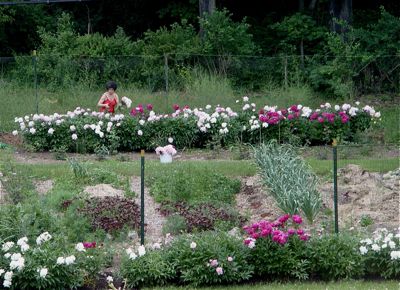
After all, one of the things that’s great about peonies is that deer really do seem to leave them alone. So this year, finally, we’re movin’ ‘em on out. And I’ve bought new different peonies to plant closer to the house. Read More…
Another in the wild mushroom series from Bill Bakaitis, who is really warmin’ up to this. It’s a little different from the others in that it’s a primer on a mushroom I’m not crazy about, but plenty of other people like them (especially people from Eastern Europe), and a honey mushroom lover sings their praises at the very end of the post.
Mushrooms of Autumn: The complex Honey
story and photos by Bill Bakaitis
Mowing our lawn in New York a few days ago I was impressed by the number of Honey mushrooms that had sprung up. They seemed to be everywhere. Although Leslie and I do not eat them, many do, and from the Poison Control calls that come in at this time of year, we know that they cause problems for a number of people. It therefore seems appropriate to mention them in this treatment of Autumn Mushrooms. Here then part of the complexity of Honeys.
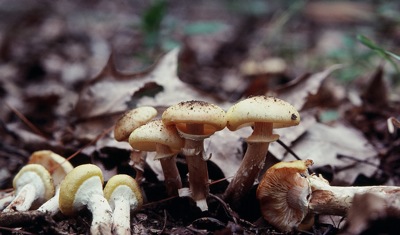
Armillaria mellea, The Honey Mushroom, yellow form
Read More…
Another piece of not-exactly amazing news: being physically warmed up – by holding a hot drink, for instance – makes people feel more warmly toward others, more generous, more tolerant, while getting chilled – by holding a coldpak, for instance – has the opposite effect. You can read all about it here or here.
And then you can be sorry all over again that “global warming” has gotten established as the shorthand for catastrophic climate change. Warm is a hugely positive word, as others before me have been pointing out for some time. If you’re trying to sound the alarm about human-caused atmospheric changes that have enormous downsides (flood, drought, and biblically destructive storms, for starters), using a word that’s more or less synonymous with “good” is probably not such a great idea.
Same problem with undifferentiated “climate change,” given that – as you may have heard lately – change can be something desirable.

frost didn't hit the cosmos until mid-October, two weeks later than usual
Do I have a solution? Not for for the main problem, and not (at least so far) for what to call it. But for the keep yourself feeling warm part, can’t beat
Cream of (wild) Mushroom Soup
Rich in flavor but comparatively light in texture, a redemption of the genre. Also – if you tweak it a bit – a redemption of any recipe that has canned cream of mushroom soup on the ingredient list.
Read More…
Much as I love Blewits, one of the greatest wild mushrooms of any season, I’ve never gotten around to doing more than throwing in a mention when talking about fall bulb planting. This omission is now remedied. Our resident wild mushroom expert explains all in
BLEWITS AND THE LEAF-FALL
by Bill Bakaitis
In the Northeast autumn leaves start to fall shortly after the equinox. This colorful event takes over a month and a half to complete, during which time the fungi of the forest floor will become increasingly difficult to see. If you are after fall mushrooms you will want to get out now, before they are completely hidden by this new leaf fall.
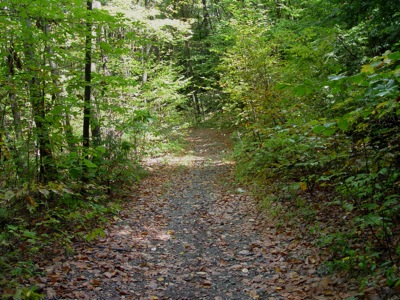
Early autumn on the mushroom trail
In a good year, like this one, autumn will begin with a tropical storm. The organic matter from the previous fall which has lain crisp and dry under the summer’s heat will revive becoming soft, moist and fragrant. In the days after the storm the air will hang hush and humid, languid with the last hot breath of summer.
Read More…

Cut in quarters and slice to serve
Here as promised in Bill’s how to find wild porcini post, is the recipe for Wild Mushroom and Caramelized Onion “Focaccia. ” The quotes are because I’m pretty sure real-deal focaccia is always plain bread with topping and this has many chunks of wild mushroom mixed into the dough. It can also have sundried tomatoes and olives, if you don’t like – or don’t have – mushrooms. Instructions for both after the jump.
Read More…
I take it back. Can’t talk too much about mushrooms when there are so many delicious all-stars popping up all over, so here’s our resident wild mushroom guru, Bill Bakaitis, on what may be the holy grail. I used the haul from Lois’ lawn to make a wild mushrom and caramelized onion focaccia, and the recipe for that will be coming soon. But first you’ve got to catch your porcini!
PORCINI: THE WHAT, THE WHERE, THE HOW TO FIND THEM
by Bill Bakaitis

Boletus edulis, the Porcino, cèpe de Bordeaux or Steinpilz
PORCINI, THE WHAT: These mushrooms are best thought of as a “species complex”, a group of rather similar Boletes that have a bun-shaped cap, a stem which tends to be stout and swollen in shape and which bears a white chicken wire like reticulation at its apex. The colors of the cap run from off white through the tans and browns to reddish. The taste is usually described as ‘nutty”. Read More…
As the recipes – more to come! – suggest, my job is to have a great time collecting, followed by having a great time cooking and preserving. HIS job is to know where and how to look, so here’s another guest post from mushroom expert Bill Bakaitis.
Finding Chanterelles
by Bill Bakaitis
Mention ‘summer mushrooms’ around here and someone is sure to say “Oh yes, Chanterelles! They are the only mushroom I collect.”
And for good reason. They are delicious, they resist insect damage, clean up easily, are distinctive and easy to identify, and are found in beautiful locations. Oh, did I mention that they are delicious?
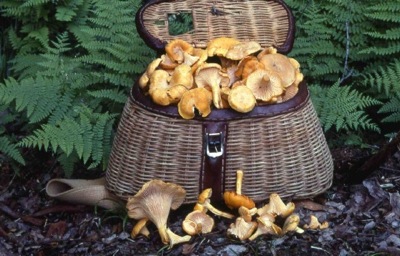 Read More…
Read More…















